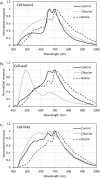Using Advanced Spectroscopy and Organic Matter Characterization to Evaluate the Impact of Oxidation on Cyanobacteria
- PMID: 31108999
- PMCID: PMC6563301
- DOI: 10.3390/toxins11050278
Using Advanced Spectroscopy and Organic Matter Characterization to Evaluate the Impact of Oxidation on Cyanobacteria
Abstract
Drinking water treatment plants throughout the world are increasingly facing the presence of toxic cyanobacteria in their source waters. During treatment, the oxidation of cyanobacteria changes cell morphology and can potentially lyse cells, releasing intracellular metabolites. In this study, a combination of techniques was applied to better understand the effect of oxidation with chlorine, ozone, potassium permanganate, and hydrogen peroxide on two cell cultures (Microcystis, Dolichospermum) in Lake Champlain water. The discrepancy observed between flow cytometry cell viability and cell count numbers was more pronounced for hydrogen peroxide and potassium permanganate than ozone and chlorine. Liquid chromatography with organic carbon and nitrogen detection was applied to monitor the changes in dissolved organic matter fractions following oxidation. Increases in the biopolymer fraction after oxidation with chlorine and ozone were attributed to the release of intracellular algal organic matter and/or fragmentation of the cell membrane. A novel technique, Enhanced Darkfield Microscopy with Hyperspectral Imaging, was applied to chlorinated and ozonated samples. Significant changes in the peak maxima and number of peaks were observed for the cell walls post-oxidation, but this effect was muted for the cell-bound material, which remained relatively unaltered.
Keywords: cell morphology; cyanobacteria; enhanced darkfield microscopy/hyperspectral imaging; intracellular organic matter; oxidation.
Conflict of interest statement
The authors declare no conflicts of interest.
Figures





Similar articles
-
Diversity Assessment of Toxic Cyanobacterial Blooms during Oxidation.Toxins (Basel). 2020 Nov 20;12(11):728. doi: 10.3390/toxins12110728. Toxins (Basel). 2020. PMID: 33233813 Free PMC article.
-
Evaluating the effectiveness of copper sulphate, chlorine, potassium permanganate, hydrogen peroxide and ozone on cyanobacterial cell integrity.Water Res. 2013 Sep 15;47(14):5153-64. doi: 10.1016/j.watres.2013.05.057. Epub 2013 Jun 11. Water Res. 2013. PMID: 23866133
-
Effect of oxidant exposure on the release of intracellular microcystin, MIB, and geosmin from three cyanobacteria species.Water Res. 2014 Apr 1;52:251-9. doi: 10.1016/j.watres.2013.11.001. Epub 2013 Nov 12. Water Res. 2014. PMID: 24289950
-
Pre-oxidation enhanced cyanobacteria removal in drinking water treatment: A review.J Environ Sci (China). 2021 Dec;110:160-168. doi: 10.1016/j.jes.2021.03.040. Epub 2021 Apr 11. J Environ Sci (China). 2021. PMID: 34593187 Review.
-
Advances and challenges in the technologies for cyanobacterial cells removal in drinking water treatment.Chemosphere. 2024 Jul;359:142338. doi: 10.1016/j.chemosphere.2024.142338. Epub 2024 May 14. Chemosphere. 2024. PMID: 38754486 Review.
Cited by
-
Monitoring of cyanobacterial breakthrough and accumulation by in situ phycocyanin probe system within full-scale treatment plants.Environ Monit Assess. 2023 Aug 17;195(9):1042. doi: 10.1007/s10661-023-11657-0. Environ Monit Assess. 2023. PMID: 37589790 Free PMC article.
-
Diversity Assessment of Toxic Cyanobacterial Blooms during Oxidation.Toxins (Basel). 2020 Nov 20;12(11):728. doi: 10.3390/toxins12110728. Toxins (Basel). 2020. PMID: 33233813 Free PMC article.
-
Delayed Release of Intracellular Microcystin Following Partial Oxidation of Cultured and Naturally Occurring Cyanobacteria.Toxins (Basel). 2020 May 20;12(5):335. doi: 10.3390/toxins12050335. Toxins (Basel). 2020. PMID: 32443714 Free PMC article.
-
Ferrate(VI) pre-treatment and subsequent chlorination of blue-green algae: Quantification of disinfection byproducts.Environ Int. 2019 Dec;133(Pt B):105195. doi: 10.1016/j.envint.2019.105195. Epub 2019 Oct 22. Environ Int. 2019. PMID: 31654918 Free PMC article.
-
Evidence-Based Framework to Manage Cyanobacteria and Cyanotoxins in Water and Sludge from Drinking Water Treatment Plants.Toxins (Basel). 2022 Jun 15;14(6):410. doi: 10.3390/toxins14060410. Toxins (Basel). 2022. PMID: 35737071 Free PMC article. Review.
References
-
- Anderson D.M., Glibert P.M., Burkholder J.M. Harmful algal blooms and eutrophication: Nutrient sources, composition, and consequences. Estuaries. 2002;25:704–726. doi: 10.1007/BF02804901. - DOI
-
- Chernoff N., Hill D.J., Diggs D.L., Faison B.D., Francis B.M., Lang J.R., Larue M.M., Le T.-T., Loftin K.A., Lugo J.N., et al. A critical review of the postulated role of the nonessential amino acid, b-N-methylamino-L- alanine, in neurodegenerative disease in humans. J. Toxicol. Environ. Health. 2017;20:183–229. doi: 10.1080/10937404.2017.1297592. - DOI - PMC - PubMed
Publication types
MeSH terms
Substances
LinkOut - more resources
Full Text Sources

